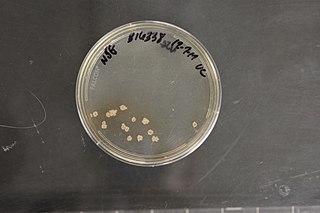
The Pasteurellaceae comprise a large family of Gram-negative bacteria. Most members live as commensals on mucosal surfaces of birds and mammals, especially in the upper respiratory tract. Pasteurellaceae are typically rod-shaped, and are a notable group of facultative anaerobes. Their biochemical characteristics can be distinguished from the related Enterobacteriaceae by the presence of oxidase, and from most other similar bacteria by the absence of flagella.

The Alteromonadales are an order of Pseudomonadota. Although they have been treated as a single family, the Alteromonadaceae, they were divided into eight by Ivanova et al. in 2004. The cells are straight or curved rods. They are motile by the use of a single flagellum. Most of the species are marine.
The Alteromonadaceae are a family of Pseudomonadota. They are now one of several families in the order Alteromonadales, including Alteromonas and its closest relatives. Species of this family are mostly rod-like shaped and motile by using one polar flagellum.
The Ectothiorhodospiraceae are a family of purple sulfur bacteria, distinguished by producing sulfur globules outside of their cells. The cells are rod-shaped, vibrioid, or spirilla, and they are able to move using flagella. In general, they are marine and prefer anaerobic conditions. Ectothiorhodospiraceae are a vibrio bacteria that require salty living conditions to survive and grow: classifying them as slightly halophilic. Like all purple sulfur bacteria, they are capable of photosynthesis. To complete this energy process, Sulfur compounds are used as electron donors for carbon fixation in the pentose phosphate pathway. This elemental sulfur accumulates outside of the cells.
The Lachnospiraceae are a family of obligately anaerobic, variably spore-forming bacteria in the order Eubacteriales that ferment diverse plant polysaccharides to short-chain fatty acids and alcohols (ethanol). These bacteria are among the most abundant taxa in the rumen and the human gut microbiota. Members of this family may protect against colon cancer in humans by producing butyric acid. Lachnospiraceae have been found to contribute to diabetes in genetically susceptible (ob/ob) germ-free mice.
Singulisphaera is a moderately acidophilic and mesophilic genus of bacteria from the family of Planctomycetaceae.
Yaniella is a genus of bacteria from the family Micrococcaceae. Yaniella is named after the Chinese microbiologist Sun-Chu Yan.
Marinifilum is a genus of bacteria from the family of Marinifilaceae.
Thermanaerovibrio is a Gram-negative, non-spore-forming chemoorganotrophic and thermophilic genus of bacteria from the family of Synergistaceae.
Natranaerobius is a halophilic and anaerobic genus of bacteria from the family of Natranaerobiaceae.
Ferrimonadaceae is a family in the order of Alteromonadales.
Niabella is a genus of bacteria from the family of Chitinophagaceae.
Terrimonas is a Gram-negative, aerobic and non-motile genus of bacteria from the family of Chitinophagaceae.
Aquisalimonas is a Gram-negative, non-endospore-forming, moderately halophilic, alkalitolerant and motile genus of bacteria from the family of Ectothiorhodospiraceae.

Stackebrandtia is a Gram-positive, aerobic and non-motile genus of bacteria from the family of Glycomycetaceae. Stackebrandtia is named after the German microbiologist Erko Stackebrandt.
Mycetocola is a Gram-positive non-spore-forming and non-motile genus from the family of Microbacteriaceae.
Gramella is a genus of bacteria from the family of Flavobacteriaceae. Gramella is named after the Danish pharmacologist Hans Christian Gram.
Salegentibacter is a genus of bacteria from the family of Flavobacteriaceae.
Marinilactibacillus is a genus of bacteria from the family of Carnobacteriaceae.
Trichococcus is a mesophilic and psychrotolerant genus of bacteria from the family of Carnobacteriaceae. Trichococcus bacteria have the ability to utilize sugars, sugar alcohols and polysaccharides. Some species of Trichococcus species where transferred from the genera Lactosphaera and Ruminococcus.


